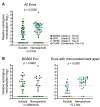Nanoparticle Vaccines for Inducing HIV-1 Neutralizing Antibodies
- PMID: 31362378
- PMCID: PMC6789800
- DOI: 10.3390/vaccines7030076
Nanoparticle Vaccines for Inducing HIV-1 Neutralizing Antibodies
Abstract
The enormous sequence diversity between human immunodeficiency virus type 1 (HIV-1) strains poses a major roadblock for generating a broadly protective vaccine. Many experimental HIV-1 vaccine efforts are therefore aimed at eliciting broadly neutralizing antibodies (bNAbs) that are capable of neutralizing the majority of circulating HIV-1 strains. The envelope glycoprotein (Env) trimer on the viral membrane is the sole target of bNAbs and the key component of vaccination approaches aimed at eliciting bNAbs. Multimeric presentation of Env on nanoparticles often plays a critical role in these strategies. Here, we will discuss the different aspects of nanoparticles in Env vaccination, including recent insights in immunological processes underlying their perceived advantages, the different nanoparticle platforms and the various immunogenicity studies that employed nanoparticles to improve (neutralizing) antibody responses against Env.
Keywords: HIV-1 Env; liposomes; self-assembling protein nanoparticles; virus-like particles.
Conflict of interest statement
The authors declare no conflict of interest.
Figures

Similar articles
-
A Rare Mutation in an Infant-Derived HIV-1 Envelope Glycoprotein Alters Interprotomer Stability and Susceptibility to Broadly Neutralizing Antibodies Targeting the Trimer Apex.J Virol. 2020 Sep 15;94(19):e00814-20. doi: 10.1128/JVI.00814-20. Print 2020 Sep 15. J Virol. 2020. PMID: 32669335 Free PMC article.
-
Membrane Env Liposomes Facilitate Immunization with Multivalent Full-Length HIV Spikes.J Virol. 2021 Jun 10;95(13):e0000521. doi: 10.1128/JVI.00005-21. Epub 2021 Jun 10. J Virol. 2021. PMID: 33883221 Free PMC article.
-
Strategies for inducing effective neutralizing antibody responses against HIV-1.Expert Rev Vaccines. 2019 Nov;18(11):1127-1143. doi: 10.1080/14760584.2019.1690458. Epub 2019 Dec 2. Expert Rev Vaccines. 2019. PMID: 31791150 Free PMC article. Review.
-
Positive Selection at Key Residues in the HIV Envelope Distinguishes Broad and Strain-Specific Plasma Neutralizing Antibodies.J Virol. 2019 Mar 5;93(6):e01685-18. doi: 10.1128/JVI.01685-18. Print 2019 Mar 15. J Virol. 2019. PMID: 30567996 Free PMC article.
-
Strategies for induction of HIV-1 envelope-reactive broadly neutralizing antibodies.J Int AIDS Soc. 2021 Nov;24 Suppl 7(Suppl 7):e25831. doi: 10.1002/jia2.25831. J Int AIDS Soc. 2021. PMID: 34806332 Free PMC article. Review.
Cited by
-
Immunofocusing and enhancing autologous Tier-2 HIV-1 neutralization by displaying Env trimers on two-component protein nanoparticles.NPJ Vaccines. 2021 Feb 9;6(1):24. doi: 10.1038/s41541-021-00285-9. NPJ Vaccines. 2021. PMID: 33563983 Free PMC article.
-
Rational design of next-generation filovirus vaccines with glycoprotein stabilization, nanoparticle display, and glycan modification.bioRxiv [Preprint]. 2025 Mar 2:2025.03.02.641072. doi: 10.1101/2025.03.02.641072. bioRxiv. 2025. PMID: 40060701 Free PMC article. Preprint.
-
Innovative vaccine platforms against infectious diseases: Under the scope of the COVID-19 pandemic.Int J Pharm. 2021 Dec 15;610:121212. doi: 10.1016/j.ijpharm.2021.121212. Epub 2021 Oct 20. Int J Pharm. 2021. PMID: 34687816 Free PMC article. Review.
-
Characterization and Immunogenicity of HIV Envelope gp140 Zera® Tagged Antigens.Front Bioeng Biotechnol. 2020 Apr 9;8:321. doi: 10.3389/fbioe.2020.00321. eCollection 2020. Front Bioeng Biotechnol. 2020. PMID: 32328488 Free PMC article.
-
Conserved multiepitope vaccine constructs: A potent HIV-1 therapeutic vaccine in clinical trials.Braz J Infect Dis. 2023 May-Jun;27(3):102774. doi: 10.1016/j.bjid.2023.102774. Epub 2023 May 5. Braz J Infect Dis. 2023. PMID: 37156468 Free PMC article. Review.
References
-
- UNAIDS Fact Sheet—Latest Global and Regional Statistics on the Status of the AIDS Epidemic. [(accessed on 19 March 2019)]; Available online: http://www.unaids.org/sites/default/files/media_asset/UNAIDS_FactSheet_e....
Publication types
Grants and funding
LinkOut - more resources
Full Text Sources

